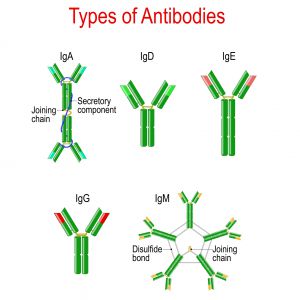
Secretory IgA (sIgA) – The Power of Immune Exclusion for Seasonal Allergies
If you could send your patients out into the world with a shield along every mucosal surface to help prevent infection and allergic responses, would you? The potent shield naturally secreted onto every mucosal surface is the specialized antibody known as secretory IgA (sIgA), and you can test sIgA levels in all patients. Secretory IgA works via immune exclusion, which is characterized by blocking pathogens, allergens, and other antigens from entering the body.
Secretory IgA physically binds to and blocks antigens – including pollen, influenza, dust, coronaviruses, pet dander, and others – from causing an infection or allergic response. Secretory IgA is the best ally to have around when seasonal allergies bloom!
The Mucosal Immune System – The First Line of Defense During Allergy Season
The moist tissues that line the nasal passages, sinuses, mouth, and throat are known as mucosal surfaces. Since these surfaces are exposed to the outside world, they have a robust mucosal immune system to protect them. With every breath, airways are exposed to innumerable and invisible toxins, allergens, and pathogens. If mucosal immunity is not optimal, allergens and respiratory viruses can quickly invade the body, causing inflammation, infection, and dysfunction.1
One of the first lines of defense against allergens (and pathogens!) is an extraordinary and specialized antibody known as Secretory IgA (sIgA), which is naturally produced by the mucosal immune system. Nutrient deficiencies, chronic stress, high cortisol levels, chronic infections, and other factors can significantly diminish the production of protective sIgA.2-5
 What is Secretory IgA (sIgA)?
What is Secretory IgA (sIgA)?
Secretory Immunoglobulin A, also known as Secretory IgA or sIgA, is a specialized antibody that functions outside the body on mucosal surfaces. IgA was first discovered in 1953 and is the most abundant immunoglobulin produced along the mucosal surfaces.6 Studies show approximately 74% of all mucosal antibodies are IgA antibodies.1
Immunoglobulin A (IgA), or monomeric IgA, is one antibody isotype produced by the immune system. Other antibody isotypes include IgG, IgD, IgE, and IgM. To produce sIgA, two IgA molecules are linked together along with a secretory component. Secretory IgA is also referred to as multimeric or dimeric IgA.1,7 More IgA antibodies are produced daily than the total amount of all other antibody isotypes combined.1 This picture depicts the structure of the different antibody isotypes: Secretory IgA is considered a protective and anti-inflammatory antibody, while other antibodies primarily have an inflammatory effect. For example, when an IgG antibody interacts with a pathogen, it has the ability to kill it, which sounds beneficial, but this process can cause a high level of inflammation that damages cells and tissues.8 IgA antibodies can prevent infections and allergic reactions via several mechanisms that minimize systemic inflammation and damage.
Secretory IgA is considered a protective and anti-inflammatory antibody, while other antibodies primarily have an inflammatory effect. For example, when an IgG antibody interacts with a pathogen, it has the ability to kill it, which sounds beneficial, but this process can cause a high level of inflammation that damages cells and tissues.8 IgA antibodies can prevent infections and allergic reactions via several mechanisms that minimize systemic inflammation and damage.
Because of its unique immunosuppressive and immunomodulatory capabilities, IgA helps to maintain homeostasis at the mucosal barrier. Maintaining a balance in inflammatory and anti-inflammatory activity is a challenge since the mucosal surfaces are permanently exposed to an enormous variety of both harmful and harmless organisms, compounds, and molecules.9 More research has been performed on the protective activities of sIgA in the GI tract than in the airways. However, similar mechanisms are likely to occur in the respiratory mucosal tissues to maintain health during the allergy season.9
 Secretory IgA – Blocking Allergens & Pathogens to Maintain Seasonal Health for Life
Secretory IgA – Blocking Allergens & Pathogens to Maintain Seasonal Health for Life
Secretory IgA begins to protect health in infancy since it is the predominant immunoglobulin present in breastmilk. In infants, the sIgA in breast milk protects against acute infections, reduces the risk of allergies, and supports lifelong health. Research shows a lack of sIgA in early life due to being formula-fed rather than breastfed may increase the risk of developing inflammatory bowel disease (IBD), obesity, allergies, and autoimmune disorders, including asthma.6
The total surface area of the respiratory and digestive tracts is approximately 200 times larger than that of the skin. Approximately 60–70% of white blood cells reside in the mucosal tissues for protection since the mucosal surfaces are incessantly exposed to microorganisms, allergens, and toxins from the outside world.5 Secretory IgA is secreted in and binds to the mucus layer that covers and protects the mucosal surfaces from allergens and pathogens, including viruses.9
How Does Secretory IgA (sIgA) Prevent Viral Infections?
Secretory Immunoglobulin A (sIgA) is a unique and protective antibody that operates on the moist surfaces of the mouth, throat, and sinuses, safeguarding them from the innumerable substances they encounter from the surrounding environment. Secretory IgA serves as a preventive barrier against viral infections (and allergens), minimizing inflammation and damage to the body.9
Secretory IgA and the mucosal immune system are truly indispensable during the cold and flu season, shielding areas of the body that are most exposed to external elements.8,9 In the GI tract, research shows sIgA protects the mucosal tissues from infectious pathogens by:
- Neutralizing pathogens, including viruses
- Developing the composition of the beneficial commensal microbiota
- Preventing harmful inflammatory responses to pathogens, foods, allergens, and other substances that interact with the mucosal surfaces9
Doctors and scientists suspect sIgA protects the respiratory tract from allergens and pathogens via similar mechanisms.9 When present in mucosal secretions, sIgA molecules bind to infectious pathogens, including viruses, thus preventing their adhesion and entrance into the body. The bound sIgA molecules then facilitate their elimination.2,10
Preventing the adhesion and absorption of pathogenic organisms while also facilitating their removal is a phenomenon known as “immune exclusion.” Two additional methods by which sIgA molecules reduce the likelihood of viral infections include direct interference with surface receptor binding and a reduction in the activation and expression of pathogenic virulence factors.2
How Does sIgA Reduce & Prevent Seasonal Allergies?
Secretory IgA plays an important role when seasonal allergies are prevalent. Monomeric IgA and sIgA antibodies modulate allergic immune responses via several mechanisms.10
Mucosal sIgA prevents the absorption and promotes the elimination of allergens via immune exclusion. Immune exclusion reduces and prevents inflammatory and allergic responses against the allergens. Furthermore, mucosal sIgA forms aggregates with allergens in secretions that can impact inflammatory signaling.10
Monomeric IgA induces anti-inflammatory responses. Monomeric IgA also directly competes with IgE for binding with allergens, thereby diminishing IgE-mediated allergic reactions.10
Are you and your patients adequately protected by sIgA antibodies?
The Secretory IgA (sIgA) Test
It is wise to assess total intestinal and salivary sIgA levels at least once or twice annually to observe any aberrations in immune resilience. Being proactive about testing and optimizing sIgA production will keep you and your patients prepared for seasonal allergies, the cold & flu season, and other immune challenges year-round.
 Naturally Boost Secretory IgA (sIgA) Levels for a Pleasant Allergy Season
Naturally Boost Secretory IgA (sIgA) Levels for a Pleasant Allergy Season
Research indicates that a combination of lifestyle modifications and supplements can help maintain optimal sIgA production. Consider:
- Nutritional support, such as Zinc, Selenium, and Vitamins C, E, A, and D311-18
- Herbal assistance from Adaptogens (Ashwagandha), Astragalus, and Elderberry19-22
- Probiotics, including Lactobacillus, Bifidobacterium, and Saccharomyces boulardii22-35
- Stress management techniques, like meditation, therapy dogs, and music3,36-44
- Regular moderate exercise and resistance training45-48

Keep yourself and your patients healthy year-round by testing for and optimizing the production of sIgA.
DiagnosTechs offers several test panels that assess sIgA levels.
Total Salivary Secretory IgA (sIgA) can be ordered as part of an:
Total Intestinal Secretory IgA (sIgA) can be ordered as part of a:
- Gastrointestinal Health Panel
- Expanded Gastrointestinal Health Panel
- Calprotectin Plus Panel
- Customized Flexi-Matrix panel
Total Intestinal sIgA and Total Salivary sIgA can also be ordered as single tests.
 To place a test order, click here. As a reminder, DiagnosTechs will drop ship test kits directly to your patients. You may select this option at the top of the order form.
To place a test order, click here. As a reminder, DiagnosTechs will drop ship test kits directly to your patients. You may select this option at the top of the order form.
Please visit our Provider Tools page for more information about choosing the right test and mucosal immunity.
 References:
References:
- Bohländer F. A new hope? Possibilities of therapeutic IgA antibodies in the treatment of inflammatory lung diseases. Front Immunol. 2023;14:1127339. doi:10.3389/fimmu.2023.1127339
- Assessing the impact of stress on the immune system. DiagnosTechs, Inc. May 9, 2020. Accessed August 14, 2023. https://www.diagnostechs.com/2020/03/30/30570/.
- Engeland CG, Hugo FN, Hilgert JB, et al. Psychological distress and salivary secretory immunity. Brain Behav Immun. 2016;52:11-17. doi:10.1016/j.bbi.2015.08.017
- Foks-Ciekalska A, Jarząb J, Hadas E, et al. The Effect of Biological Treatment on Stress Parameters Determined in Saliva in Patients with Severe Psoriasis. Medicina (Kaunas). 2023;59(4):692. doi:10.3390/medicina59040692
- Gallagher S, Phillips AC, Evans P, et al. Caregiving is associated with low secretion rates of immunoglobulin A in saliva. Brain Behav Immun. 2008;22(4):565-572. doi:10.1016/j.bbi.2007.11.007
- Guo J, Ren C, Han X, et al. Role of IgA in the early-life establishment of the gut microbiota and immunity: Implications for constructing a healthy start. Gut Microbes. 2021;13(1):1-21. doi:10.1080/19490976.2021.1908101
- de Fays C, Carlier FM, Gohy S, Pilette C. Secretory Immunoglobulin A Immunity in Chronic Obstructive Respiratory Diseases. Cells. 2022;11(8):1324. doi:10.3390/cells11081324
- Kurono Y. The mucosal immune system of the upper respiratory tract and recent progress in mucosal vaccines. Auris Nasus Larynx. 2022;49(1):1-10.
- Sánchez Montalvo A, Gohy S, Rombaux P, et al. The Role of IgA in Chronic Upper Airway Disease: Friend or Foe?. Front Allergy. 2022;3:852546. doi:10.3389/falgy.2022.852546
- Scheurer S, Junker AC, He C, et al. The Role of IgA in the Manifestation and Prevention of Allergic Immune Responses. Curr Allergy Asthma Rep. 2023;23(10):589-600. doi:10.1007/s11882-023-01105-x
- Xu C, Sun R, and Qiao X. Effect of vitamin e supplementation on intestinal barrier function in rats exposed to high altitude hypoxia environment. Korean J Physiol Pharmacol. 2014;18(4):313-20.
- Muir W, Husband A, and Bryden W. Dietary supplementation with vitamin E modulates avian intestinal immunity. Br J Nutr. 2002;87(6):579-85.
- Lyu Y, Wu L, Wang F, et al. Carotenoid supplementation and retinoic acid in immunoglobulin A regulation of the gut microbiota dysbiosis. Exp Biol Med (Maywood). 2018;243(7):613-620.
- Scott J, Kazman J, Palmer J, et al. Effects of vitamin D supplementation on salivary immune responses during Marine Corps basic training. Scand J Med Sci Sports. 2019;29(9):1322-1330.
- Gan L, Fan H, Mahmood T, Guo Y. Dietary supplementation with vitamin C ameliorates the adverse effects of Salmonella Enteritidis-challenge in broilers by shaping intestinal microbiota. Poult Sci. 2020;99(7):3663-3674. doi:10.1016/j.psj.2020.03.062
- Bortoluzzi C, Lumpkins B, Mathis GF, et al. Zinc source modulates intestinal inflammation and intestinal integrity of broiler chickens challenged with coccidia and Clostridium perfringens. Poult Sci. 2019;98(5):2211-2219.
- Levkut M, Levkutová M, Grešáková Ľ, et al. Production of Intestinal Mucins, sIgA, and Metallothionein after Administration of Zinc and Infection of Ascaridia galli in Chickens: Preliminary Data. Life (Basel). 2022;13(1):67. doi:10.3390/life13010067
- Dalia A, Loh T, Sazili A, et al. Effects of vitamin E, inorganic selenium, bacterial organic selenium, and their combinations on immunity response in broiler chickens. BMC Vet Res. 2018;14(1):249.
- Guo FC, Kwakkel RP, Williams BA, et al. Effects of mushroom and herb polysaccharides on cellular and humoral immune responses of Eimeria tenella-infected chickens. Poult Sci. 2004;83(7):1124-32.
- Ruili Z, Qun Y, Guangliang S, et al. chTLR4 pathway activation by Astragalus polysaccharide in bursa of Fabricius. BMC Vet Res. 2017;13:119.
- Yamada K, Hung P, Kyu Park T, et al. A Comparison of the Immunostimulatory Effects of the Medicinal Herbs Echinacea, Ashwagandha and Brahmi. J Ethnopharmacol. 2011;137(1):231-5.
- Coman MM, Micioni Di Bonaventura MV, et al. SYNBIO® Probiotic and Antioxidant Dietary Supplementation: Clinical Trial Evaluation of Potential Effects on Airline Flight Crew Members’ Well-Being. Microorganisms. 2023;11(4):924. doi:10.3390/microorganisms11040924
- Tremblay A, Xu X, Colee J, Tompkins TA. Efficacy of a Multi-Strain Probiotic Formulation in Pediatric Populations: A Comprehensive Review of Clinical Studies. Nutrients. 2021;13(6):1908. doi:10.3390/nu13061908
- L, Gong C, Ding Y, et al. Probiotics maintain intestinal secretory immunoglobulin A levels in healthy formula-fed infants: a randomised, double-blind, placebo-controlled study. Benef Microbes. 2019;10(7):729-739. doi:10.3920/BM2019.0025
- Lara-Villoslada F, Sierra S, Boza J, et al. [Beneficial effects of consumption of a dairy product containing two probiotic strains, Lactobacillus coryniformis CECT5711 and Lactobacillus gasseri CECT5714 in healthy children]. Nutr Hosp. 2007;22:496-502.
- Gleeson M, Bishop NC, Oliveira M, Tauler P. Daily probiotic’s (Lactobacillus casei Shirota) reduction of infection incidence in athletes. Int J Sport Nutr Exerc Metab. 2011;21(1):55-64.
- Kusumo P, Bela B, Wibowo H, et al. Lactobacillus plantarum IS-10506 supplementation increases faecal sIgA and immune response in children younger than two years. Benef Microbes. 2019;10(3):245-252.
- Zhang J, Deng J, Wang Z, et al. Modulatory effects of Lactobacillus salivarius on intestinal mucosal immunity of piglets. Curr Microbiol. 2011;62(5):1623-31.
- Pahumunto N, Sophatha B, Piwat S, et al. Increasing salivary IgA and reducing Streptococcus mutans by probiotic Lactobacillus paracasei SD1: A double-blind, randomized, controlled study. J Dent Sci. 2019;14(2):178-184.
- Garcia-Castillo V, Komatsu R, Clua P, et al. Evaluation of the Immunomodulatory Activities of the Probiotic Strain Lactobacillus fermentum UCO-979C. Front Immunol. 2019;10:1376.
- Azad MAK, Sarker M, Wan D. Immunomodulatory Effects of Probiotics on Cytokine Profiles. Biomed Res Int. 2018;2018:8063647. doi:10.1155/2018/8063647
- Takahashi T, Nakagawa E, Nara T, et al. Effects of orally ingested Bifidobacterium longum on the mucosal IgA response of mice to dietary antigens. Biosci Biotechnol Biochem. 1998;62(1):10-5.
- Mohan R, Koebnick C, Schildt J, et al. Effects of Bifidobacterium lactis Bb12 supplementation on body weight, fecal pH, acetate, lactate, calprotectin, and IgA in preterm infants. Pediatr Res. 2008;64(4):418-22.
- Terahara M, Nakamura Y, Tsuboi M, et al. Effects of the intake of non-live Bifidobacterium bifidum on the faecal IgA of full-term infants: a double-blind, randomised, placebo-controlled study. Biosci Microbiota Food Health. 2021;40(4):196-203. doi:10.12938/bmfh.2021-018
- Rajput I, Ying H, Yajing S, et al. Saccharomyces boulardii and Bacillus subtilis B10 modulate TLRs and cytokines expression patterns in jejunum and ileum of broilers. PLoS One. 2017;12(3):e0173917.
- Phillips AC, Carroll D, Evans P, et al. Stressful life events are associated with low secretion rates of immunoglobulin A in saliva in the middle aged and elderly. Brain Behav Immun. 2006;20(2):191-7.
- Hanstock H, Edwards J, Roberts R, et al. High heart rate reactors display greater decreases in tear SIgA concentration following a novel acute stressor. Biol Psychol. 2018;133:85-88.
- Staley M, Conners M, Hall K, et al. Linking Stress and Immunity: Immunoglobulin A as a Non-Invasive Physiological Biomarker in Animal Welfare Studies. Horm Behav. 2018;102:55-68.
- Goyal M, Singh S, Sibinga E, et al. Meditation Programs for Psychological Stress and Well-Being: A Systematic Review and Meta-Analysis. JAMA Intern Med. 2014;174(3):357-68.
- Torkamani F, Aghayousefi A, Alipour A, et al. Effects of Single-Session Group Mantra-meditation on Salivary Immunoglobulin A and Affective State: A Psychoneuroimmunology Viewpoint. Explore (NY). 2018;14(2):114-121.
- Charnetski CJ, Riggers S, Brennan FX. Effect of petting a dog on immune system function. Psychol Rep. 2004;95:1087-91.
- Fancourt D, Ockelford A, Belai A. The psychoneuroimmunological effects of music: a systematic review and a new model. Brain Behav Immun. 2014;36:15-26.
- Hucklebridge F, Lambert S, Clow A, et al. Modulation of secretory immunoglobulin A in saliva; response to manipulation of mood. Biol Psychol. 2000;53(1):25-35.
- Green M, Green R, Santoro W, et al. Daily Relaxation Modifies Serum and Salivary Immunoglobulins and Psychophysiologic Symptom Severity. Biofeedback Self Regul. 1988;13(3):187-99.
- Martins R, Cunha M, Neves A, et al. Effects of aerobic conditioning on salivary IgA and plasma IgA, IgG and IgM in older men and women. Int J Sports Med. 2009;30(12):906-12.
- Drago-Serrano M, Godínez-Victoria M, Lara-Padilla E, et al. Moderate exercise enhances expression of SIgA in mouse ileum. Int J Sports Med. 2012;33(12):1020-5.
- Fornieles G, Rosety M, Elosegui S, et al. Salivary testosterone and immunoglobulin A were increased by resistance training in adults with Down syndrome. Braz J Med Biol Res. 2014;47(4):345-8.
- Hwang Y, Park J, Lim K. Effects of Pilates Exercise on Salivary Secretory Immunoglobulin A Levels in Older Women. J Aging Phys Act. 2016;24(3):399-406.






